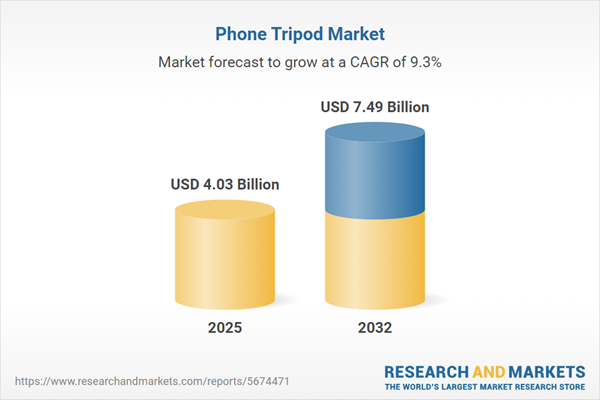Speak directly to the analyst to clarify any post sales queries you may have.
The phone tripod market is shaping digital collaboration and professional content production across industries, offering flexible solutions designed for dynamic business environments. Senior decision-makers are increasingly adopting these tools to support efficient workflow integration and drive content quality in organizational settings.
Market Snapshot: Phone Tripod Market Size and Growth Trajectory
The global phone tripod market is demonstrating consistent expansion, with revenue projected to rise from USD 3.69 billion in 2024 to USD 4.03 billion in 2025 and an estimated market value of USD 7.49 billion by 2032. This trajectory reflects a compound annual growth rate (CAGR) of 9.25%. This upward movement is driven by increasing adoption among professional studios, enterprise production teams, live-streaming providers, and agencies dedicated to digital content creation. The spike in hybrid and remote work further accelerates business investment in phone tripod solutions, helping organizations enhance digital collaboration, operational flexibility, and overall productivity.
Scope & Segmentation: Key Factors Shaping the Phone Tripod Market
- Product Types: Extension tripods cater to adjustable-height shooting needs. Flexible tripods offer support for filming in irregular environments. Selfie tripods deliver Bluetooth or wired controls for interactive uses. Standard and tabletop tripods serve deployments from large studios to compact offices.
- End User Profiles: Consumer segments leverage phone tripods for personal media, while professional creators and enterprise teams focus on compatibility, scalability, and aligning with broader business goals.
- Distribution Channels: Direct sales and managed contracts simplify institutional procurement. Retail and e-commerce channels support adaptive sourcing to accommodate diverse business requirements.
- Applications: Tripods facilitate live streaming, video conferencing, vlogging, photographic documentation, and comprehensive multimedia production for seamless communications and content delivery.
- Mount Types: Clamp, screw, and magnetic options enable swift equipment changes, increasing efficiency when adapting to new projects or frequent workflow changes.
- Material Types: Choices such as aluminum, carbon fiber, stainless steel, and plastic blends balance longevity with portability, streamlining asset management and minimizing upkeep.
- Price Range: Premium, mid-tier, and value models allow organizations to customize procurement, optimizing for specific investment strategies and cost structures.
- Regions Covered: The Americas, Europe, Middle East & Africa, and Asia-Pacific each exhibit unique purchasing behaviors and integration practices, reflecting regional preferences and operational norms.
Key Takeaways for Senior Decision-Makers
- Mobile and modular tripod systems are overcoming connectivity and setup challenges in remote and distributed work models, supporting uninterrupted collaboration.
- Lightweight materials such as carbon fiber alleviate user fatigue, particularly for field-based employees handling frequent equipment deployment or adjustment.
- Organizations benefit from tools that streamline device integration, ensuring tripods support key productivity apps and meet the requirements of digital collaboration platforms.
- Modern procurement processes leverage data-driven tools, helping companies identify solutions that reflect both manager input and operational needs while maximizing ROI.
- Flexible price tiers and product ranges empower procurement teams to manage spend efficiently while meeting technology alignment objectives across departments.
- Business leaders are utilizing advanced tripod options to enhance scalability and agility, ensuring that production setups can evolve with shifting business priorities.
Tariff Impact: Navigating Raw Material Cost Pressures
With new U.S. tariff policies expected in 2025, manufacturers face the need to revisit sourcing and supply strategies. Building broader supplier bases and nurturing strong regional partnerships are crucial to managing cost fluctuations in raw materials. Reinforced logistics frameworks serve to stabilize the supply of accessories, mitigating procurement risk for businesses scaling up their content production capabilities. Transparent and adaptable pricing, coupled with tailored buying approaches by region, helps organizations sustain inventory reliability and operational continuity.
Methodology & Data Sources
This market research report is the result of in-depth sector analysis, an evaluation of patent trends, and direct interviews with industry experts. Ongoing engagement with market specialists and business leaders ensures the data addresses current demands and market shifts in the phone tripod ecosystem.
Why This Report Matters for Phone Tripod Industry Leaders
- Empowers organizations to anticipate emerging digital collaboration trends and enhance procurement processes within a connected B2B environment.
- Strengthens resilience by supporting rapid adaptation to regulatory changes and global supply variations.
- Reveals investment and partnership strategies, bolstering organizational flexibility and expansion potential amid competitive market dynamics.
Conclusion
This report equips senior leaders with actionable insights to refine procurement, boost adaptability, and maintain effective content operations as market conditions and collaboration needs continue to evolve.
Additional Product Information:
- Purchase of this report includes 1 year online access with quarterly updates.
- This report can be updated on request. Please contact our Customer Experience team using the Ask a Question widget on our website.
Table of Contents
3. Executive Summary
4. Market Overview
7. Cumulative Impact of Artificial Intelligence 2025
Companies Mentioned
The companies profiled in this Phone Tripod market report include:- Manfrotto Distribution S.p.A.
- Joby, Inc.
- Ulanzi Technology Co., Ltd.
- Neewer Technology Co., Ltd.
- Benro Machinery Industrial Co., Ltd.
- Peak Design, Inc.
- Zhiyun Innovation Technology Co., Ltd.
- Gudsen Technology Co., Ltd.
- SmallRig Technology Co., Ltd.
- Shenzhen Fotopro Photo Industry Co., Ltd.
Table Information
| Report Attribute | Details |
|---|---|
| No. of Pages | 190 |
| Published | October 2025 |
| Forecast Period | 2025 - 2032 |
| Estimated Market Value ( USD | $ 4.03 Billion |
| Forecasted Market Value ( USD | $ 7.49 Billion |
| Compound Annual Growth Rate | 9.2% |
| Regions Covered | Global |
| No. of Companies Mentioned | 11 |








